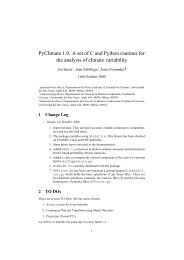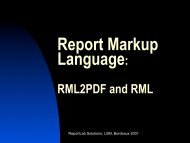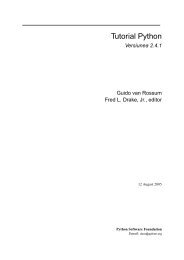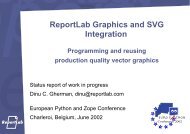PyClimate 1.1. A set of C and Python routines for the ... - Starship
PyClimate 1.1. A set of C and Python routines for the ... - Starship
PyClimate 1.1. A set of C and Python routines for the ... - Starship
Create successful ePaper yourself
Turn your PDF publications into a flip-book with our unique Google optimized e-Paper software.
Class: JDTimeH<strong>and</strong>lerFunction: def init (self,units)The creator parses a COARDS–type units attribute <strong>of</strong> <strong>the</strong> netCDF time variable (ex:hours since 1958-01-01 0:0) <strong>and</strong> computes <strong>the</strong> <strong>of</strong>f<strong>set</strong> <strong>and</strong> <strong>the</strong> scale factor to get JulianDays from <strong>the</strong> netCDF time variable <strong>for</strong> each record.Function: def getdatefields(self,tvalue,listlen=6)This method scales <strong>the</strong> value <strong>of</strong> tvalue using <strong>the</strong> scaling factor corresponding to <strong>the</strong>units attribute <strong>and</strong> adds <strong>the</strong> <strong>of</strong>f<strong>set</strong> computed from <strong>the</strong> units attribute, getting <strong>the</strong> JulianDay corresponding to <strong>the</strong> time coordinate tvalue. The Julian Day value is used tocreate a broken date structure, <strong>and</strong> its values (year,month,day,hour,minute,second) arereturned as a list, with as many members as those requested by listlen.Function: def gettimevalue(self,datefields,listlen=6)This function is <strong>the</strong> inverse <strong>of</strong> <strong>the</strong> previous one. It creates a Julian Day from <strong>the</strong> valuesin <strong>the</strong> list datefields (as many values as <strong>the</strong> value <strong>of</strong> listlen), computes <strong>the</strong> <strong>of</strong>f<strong>set</strong> from<strong>the</strong> origin <strong>of</strong> coordinates <strong>and</strong> scales <strong>the</strong> value to <strong>the</strong> units corresponding to <strong>the</strong> unitsattribute <strong>of</strong> <strong>the</strong> time variable used to cretae <strong>the</strong> instance <strong>of</strong> this class. Due to sometruncations which appear during <strong>the</strong> floating point operations, this function is onlyaccurate to about 12 significant figures. So, if you are creating a netCDF file fromscratch, it is more accurate <strong>and</strong> fast just to add equal time intervals using a fixed timestep from record to record.5 Distribution functionsDCDFLIB.C 1.1 is a library <strong>of</strong> C Routines <strong>for</strong> Cumulative Distribution Functionsdeveloped by Barry W. Brown, James Lovato <strong>and</strong> Kathy Russell, Department <strong>of</strong> Bioma<strong>the</strong>matics,The University <strong>of</strong> Texas, M.D. Anderson Cancer Center. The libraryallows <strong>the</strong> determination <strong>of</strong> cumulative distribution functions, inverses, <strong>and</strong> <strong>the</strong> parameters<strong>of</strong> <strong>the</strong> following statistical distributions: Beta, Binomial, , Noncentral ,, Noncentral , Gamma, Negative Binomial, Normal, Poisson, Student’s <strong>and</strong> Non-central . The file pydcdflib.py provides access to this library from <strong>Python</strong>. Foreach one <strong>of</strong> <strong>the</strong>se distributions, a class has been created that wraps <strong>the</strong> parameters in<strong>the</strong> call to <strong>the</strong> functions <strong>of</strong> this routine <strong>and</strong> some C functions that wrap <strong>the</strong> originalC calls to make <strong>the</strong>m available to <strong>the</strong> <strong>Python</strong> interpreter. The same names have beenused in <strong>the</strong> wrapping <strong>of</strong> <strong>the</strong> parameters, so that <strong>the</strong> original documentation <strong>of</strong> <strong>the</strong> DCD-FLIB.C library is valid <strong>for</strong> each <strong>of</strong> <strong>the</strong> classes in this <strong>Python</strong> extension. The class ispassed to a function with <strong>the</strong> same name <strong>of</strong> <strong>the</strong> original one (with py prepended to<strong>the</strong> name <strong>of</strong> <strong>the</strong> wrapper function). The fields <strong>of</strong> each class are updated by <strong>the</strong> wrapperfunctions. The code <strong>of</strong> <strong>the</strong> original C library is untouched. Examples on <strong>the</strong> use<strong>of</strong> <strong>the</strong>se wrappers can be obtained from <strong>the</strong> testDCDFLIB.py script in <strong>the</strong> sourcedirectory <strong>of</strong> <strong>the</strong> distribution <strong>and</strong> from <strong>the</strong> enclosed exdcdflib.py file. There is anerror when computing <strong>the</strong> parameters <strong>for</strong> <strong>the</strong> F distribution using <strong>the</strong> value which=3.This seems to be linked to <strong>the</strong> properties <strong>of</strong> <strong>the</strong> F distribution <strong>and</strong>, in case it were abug, it also exists in <strong>the</strong> original DCDFLIB.C, as <strong>the</strong> same problem appears using <strong>the</strong>C file testF.c, provided in <strong>the</strong> source directory. The documentation <strong>of</strong> <strong>the</strong> originalDCDFLIB.C library is distributed within <strong>the</strong> doc subdirectory <strong>of</strong> <strong>the</strong> distribution.8









